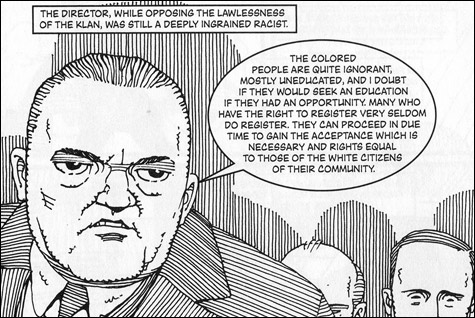People’s history in graphic format
By CLIF GARBODEN | July 1, 2008

JUST THE FACTS: Geary’s Hoover is a masterpiece of understatement. |
J. Edgar Hoover: A Graphic Biography | By Rick Geary | Hill & Wang | 110 pages | $16.95 Students For a Democratic Society: A Graphic History | Written (mostly) by Harvey Pekar | Art (mostly) by Gary Dumm | Edited by Paul Buhle | Hill & Wang | 224 pages | $22 |
Graphic novels are an acquired taste. Because they’re often driven as much by the art as by a theme, their stories tend to be, uh . . . non-linear. Which is a nice way of saying they don’t make a whole lot of sense. Not so with National Lampoon/Heavy Metal illustrator Rick Geary’s graphic bio of the notorious FBI strongman, J. Edgar Hoover, or American Splendor author Harvey Pekar’s anthology of new-left living-history reminiscences, Students for a Democratic Society.Geary’s Hoover is about as linear and minimalist a narrative as you could ask for, reeking of non-judgmental detachment that creates a masterpiece of understatement. Railing against the pompous, unyielding, dictatorial, hypocritical, closeted-gay, right-wing-extremist FBI chief would be your basic barrel-fish target exercise. Fun, but not convincing. Geary’s flat delivery, by contrast, makes Hoover’s bodacious sins, which will be as unfamiliar as they are astonishing to younger generations, all the more believable for presenting them in the passively accepting context in which they were committed.
The panel addressing FDR’s empowerment of the Bureau reads simply: “Roosevelt authorized telephone wiretaps, although such abridgment of civil rights was of questionable legality.” On Hoover’s dossier on Eleanor Roosevelt: “The first lady did not share her husband’s camaraderie with the director. . . . To Hoover, Mrs. Roosevelt was the worst sort of ‘sentimental moo-cow’ — a bleeding heart for the enemies of American society.” On competition from the newly formed CIA: “He immediately ordered a policy of non-cooperation between the FBI and this upstart group.”
Neither does Geary’s art add much excitement to the words. If anything, the images are even calmer and more matter-of-fact than the narrative, the action depicted lacking all passion — which makes the darkest points powerfully ironic. The tone is a deft parody of the goody-goody text style used in, say, the Hillary Clinton coloring book that used to be available at the Clinton Museum Store in Little Rock. It adds up to very sophisticated way of letting readers understand that Hoover was scum.
Pictured on your left
Authorship of Harvey Pekar’s “graphic history” Students for a Democratic Society is impossible to explain. The book is a collection of eyewitness accounts of scenes public and personal by veterans of the 1960s radical leftist coalition that ultimately swallowed itself and morphed into the Weather Underground. Pekar wrote most of the texts, which are co-attributed to their sources, and Gary Dumm provided most of the illustrations. There are guest writers and artists, however, and Brown professor (and long-time SDS activist) Paul Buhle is credited as editor.
 Topics
Topics:
Books
, Media, Books, Federal Bureau of Investigation, More  , Media, Books, Federal Bureau of Investigation, Hillary Clinton, Graphic Novels and Comics, Central Intelligence Agency, Phil Ochs, Paul Buhle, University of Wisconsin, Eleanor Roosevelt, Less
, Media, Books, Federal Bureau of Investigation, Hillary Clinton, Graphic Novels and Comics, Central Intelligence Agency, Phil Ochs, Paul Buhle, University of Wisconsin, Eleanor Roosevelt, Less 